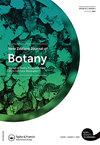马鞭草P.W.Michael:新西兰一种古老杂草的一个被忽视的名字
IF 1.4
4区 生物学
Q4 PLANT SCIENCES
引用次数: 0
摘要
摘要马鞭草原产于南美洲,在新西兰一直被误解为杂草。在澳大利亚和欧洲,马鞭草曾被混淆为博纳里马鞭草和巴西马鞭草的中间物。马鞭草于1995年被命名为一个独特的物种。直到最近,这种植物在新西兰还被误认为是博纳氏V.bonariensis,它在新西兰广泛分布,从北岛北部到南岛北部都有发现。马鞭草是一种比稀有的博纳马鞭草更健壮的植物,这些物种可以很容易地分离:无马鞭草有细长的花穗,博纳马铃草有更宽的花冠。文中讨论了新西兰的无刺V.incpta的存在和历史,并对其自1871年入籍以来的分布和入侵性进行了说明。比较和讨论了马鞭草复合体中的三个物种(无柄马鞭草和巴西马鞭草是另外两个物种),特别注意区分无柄马铃草和博纳马鞭草。这是通过对国外文献的回顾,以及对新西兰马鞭草植物标本馆材料的检查和重新鉴定来完成的。这表明无茎马鞭草是在新西兰采集的马鞭草复合体中最常见的杂草物种。本文章由计算机程序翻译,如有差异,请以英文原文为准。
Verbena Incompta P.W.Michael: an overlooked name for an old weed in New Zealand
ABSTRACT
Verbena incompta, an apparent native of South America, has been a misunderstood weed in New Zealand. Verbena incompta had been confused as intermediate between V. bonariensis and V. brasiliensis in Australia and Europe. Now Verbena incompta is known as a distinct species, being named in 1995. Until recently, this plant was mistaken for V. bonariensis in New Zealand, where it is widespread, found from the north of the North Island to the north of the South Island. Verbena incompta is a more robust plant then the rarer V. bonariensis, and these species can be easily separated: V. incompta has elongated flower spikes and V. bonariensis a broader corolla. The presence and history of the V. incompta in New Zealand is discussed with notes on its distribution and invasiveness since its naturalisation in 1871. The three species in the Verbena bonariensis complex (V. incompta and V. brasiliensis being the other two species) are compared and discussed with particular attention paid to distinguishing V. incompta and V. bonariensis. This was done through review of the overseas literature, and the examination and reidentification of herbarium material of Verbena in New Zealand. This showed that V. incompta is the most common weedy species of the Verbena bonariensis complex collected in New Zealand.
求助全文
通过发布文献求助,成功后即可免费获取论文全文。
去求助
来源期刊

New Zealand Journal of Botany
生物-植物科学
CiteScore
2.20
自引率
22.20%
发文量
27
审稿时长
>12 weeks
期刊介绍:
The New Zealand Journal of Botany publishes original research papers, review papers, perspectives, short communications, forum articles, letter and book reviews. We welcome submissions relevant to all aspects of the botany, mycology, and phycology of the South Pacific, Australia, South America, and Southern Africa. The journal’s subject matter encompasses biosystematics and biogeography, ecology, physiology, biochemistry, genetics, reproductive biology, structure and development, taxonomy, ethnobotany, palaeobotany, bryology, lichenology, mycology, plant pathology, and phycology.
 求助内容:
求助内容: 应助结果提醒方式:
应助结果提醒方式:


